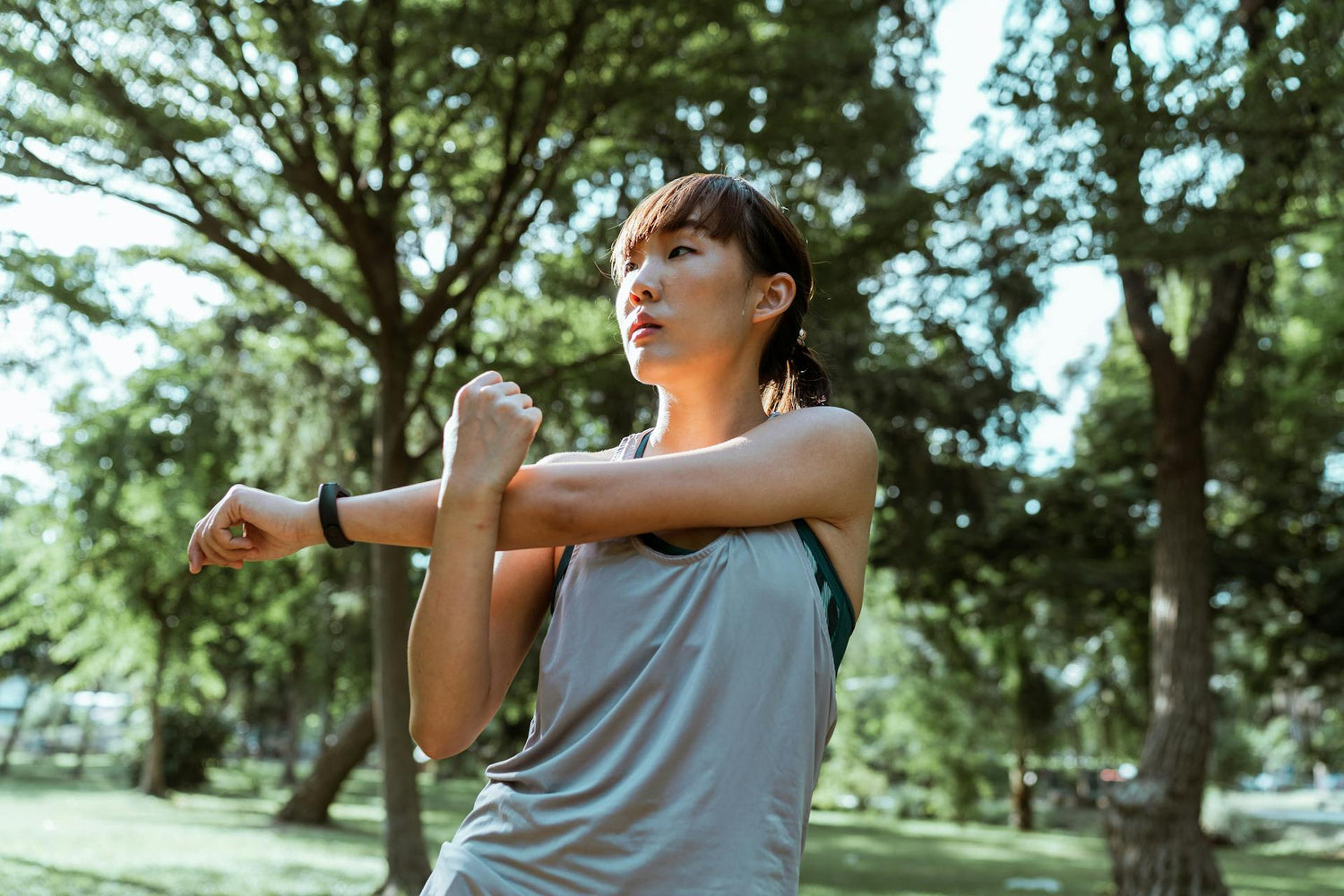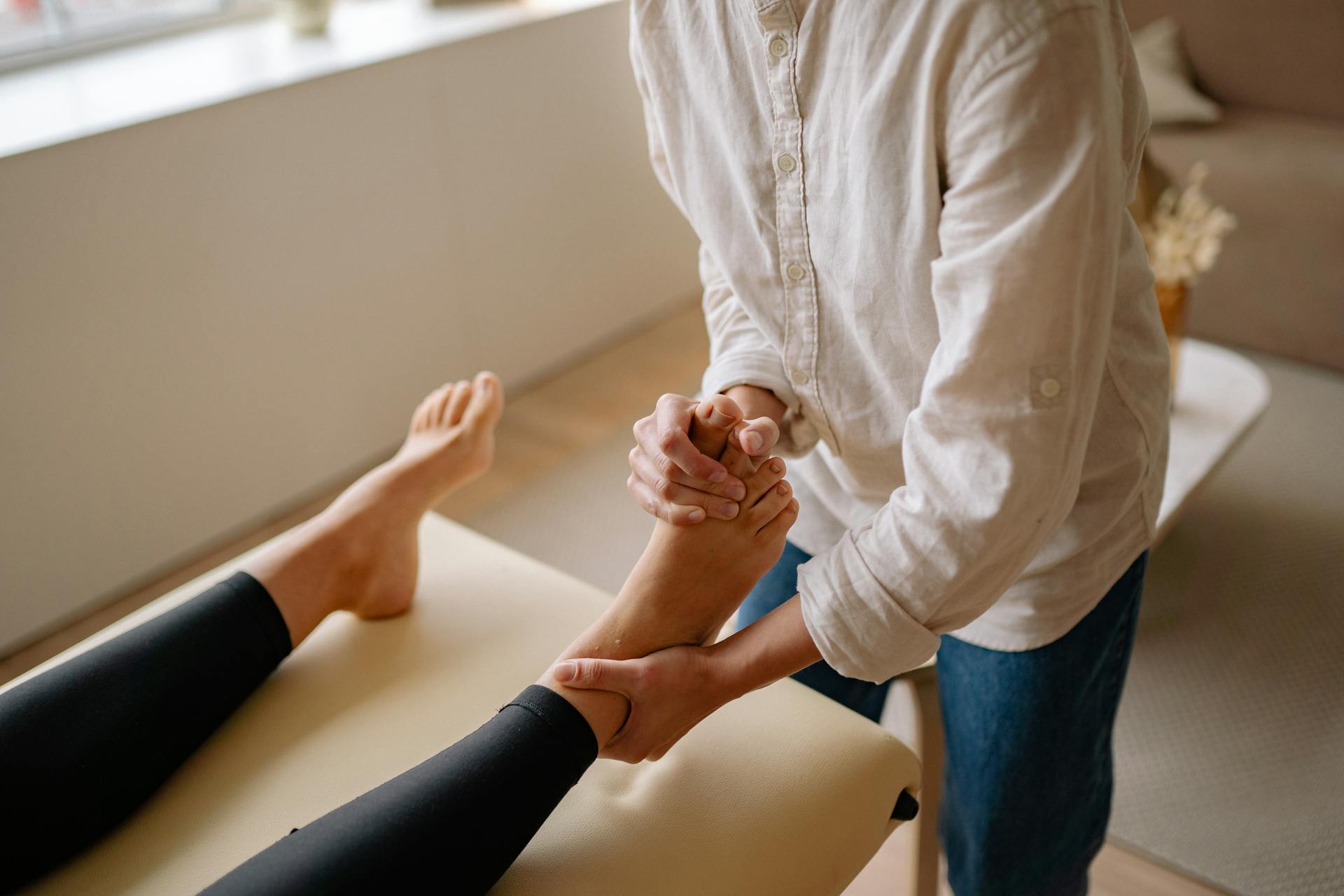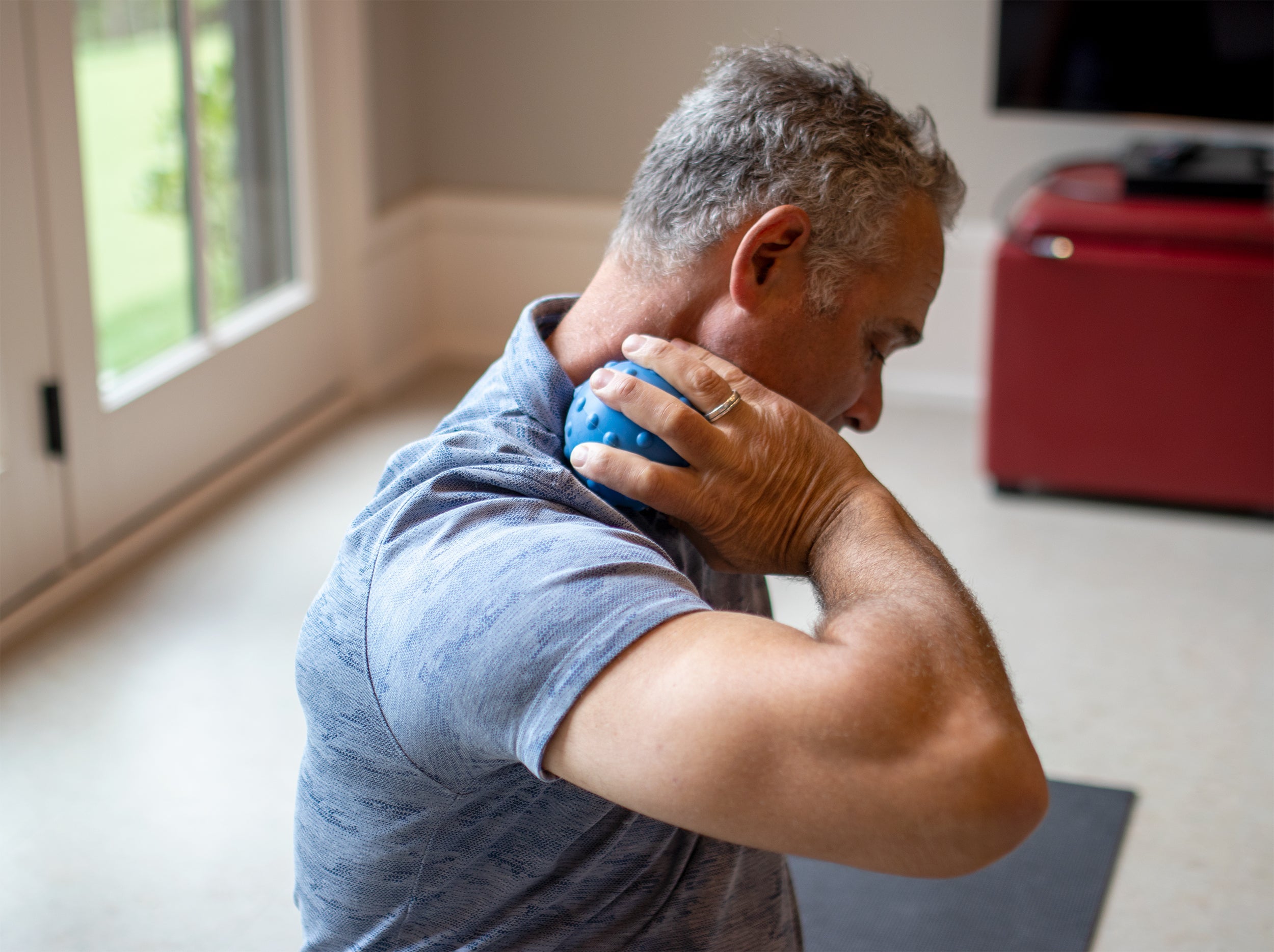Keeping your shoulders in top shape calls for regular TLC, especially when you’ve got an active or aging body. Because whether it's from lifting heavy or normal wear and tear, nearly all of us will feel stiffness in our shoulders at some point in our lives.
Fortunately, a handful of lifestyle changes can help you keep your shoulders flexible and mobile. And a bonus is that many of these techniques are free and easy to try.
Here’s everything you need to know about how to increase shoulder mobility, from stretching to massage therapy and more.
How Your Shoulders Work
Your shoulders are some of your body’s busiest, most intricate joints. The glenohumeral joint is the central joint of the shoulder, which is where your upper arm bone (humerus) fits into a rounded cavity at the end of your shoulder blade (scapula). This creates a “ball-and-socket” type of structure, allowing you to move your arms up, down, and side-to-side. Plus, it enables a wide range of external and internal arm rotation.
Aside from this main joint, the acromioclavicular joint (AC joint) also plays a role in your shoulder’s movement. This area is where your clavicle — or collarbone — meets the outer edge of the scapula (called the acromion).
Other Important Structures
All of your cartilage, tendons, and muscles work together to keep your shoulder joints cushioned and moving freely. But when any of these parts suffer injury, wear, or inflammation, you can end up with stiffness and a reduced range of motion (ROM).
With that in mind, here are some essential supporting structures that help your shoulder stay flexible and mobile:
- The labrum: This is the piece of cartilage that cushions the bones in the shoulder socket
- The rotator cuff: This is a group of muscles and tendons located on the back of the shoulder
- The deltoids: These are the muscles that lie over the shoulder joint, giving it a rounded appearance
The Causes of Reduced Shoulder Mobility
In many cases, less shoulder mobility is a simple side effect of growing older. Because as you age, you can lose some of the synovial fluid that keeps your joints lubricated. Beyond that, your cartilage, ligaments, and tendons can become less stretchy and stiffer with time.
Of course, you can mitigate these changes with regular exercise and healthy habits – but some stiffness is often entirely normal as your body ages.
That being said, there are other reasons for decreased shoulder mobility, besides simple wear and tear. And if any of these are the culprit behind your stiffness, treating them can be the best first step toward better movement. These include:
Muscle Tension and Poor Posture
You probably know that tense muscles and poor posture can bring on back pain – but did you know that it can also do the same to your shoulders?
According to the Mayo Clinic, poor posture can impact your shoulder blades’ positioning, arm movement, and muscle efficiency around the joint. In turn, this can lead to achiness, stiffness, or even shoulder impingement down the line.
Frozen Shoulder
Frozen shoulder is another common source of shoulder pain and stiffness. And as the name suggests, it can cause you to feel like your shoulder is “frozen” in place.
This condition happens when any of the tissue making up your shoulder capsule becomes injured or inflamed. It occurs in three stages — freezing, frozen, and thawing — and can take anywhere from several months to a few years to fully heal.
Arthritis
Shoulder arthritis refers to inflammation in your shoulder joint and is often associated with worn or damaged cartilage. This condition can result in decreased mobility, stiffness, and pain that worsens with specific activities. In addition, it can cause your shoulder to click, grind, or pop during certain motions.
Shoulder Impingement
When your rotator cuff tendons are swollen or inflamed, the outer edge of your shoulder blade can pinch or “impinge” them. This can lead to shoulder impingement syndrome, a condition known to cause pain and limit ROM – especially when reaching up and above your head.
Understanding Shoulder Flexibility and Mobility
When it comes to improving your shoulder movement, flexibility and mobility both play an important role. However, there are some key differences to know about before starting your new mobility routine:
- Flexibility refers to the ability of your shoulder muscles to lengthen passively
- Mobility means actively being able to move your shoulder within a wide range of motion
The goal of shoulder mobility techniques is to help you get a more active range of motion — but you may find that these tips increase your flexibility as well.
How to Increase Shoulder Mobility: 4 Top Tips

If you want to know how to increase shoulder mobility for the long haul, a variety of simple lifestyle changes can help. The strategies covered below can increase healthy blood flow, reduce tension, and improve the way your shoulders feel and move.
Here’s how to get started:
Disclaimer: Be sure to talk to your doctor before starting a new exercise routine, especially if you have any preexisting conditions. This will help you keep your shoulders healthy, avoid injury, and find a routine that suits your unique body and health.
1. Add Gentle Strength Training to Your Routine
When you think of boosting shoulder mobility, you might picture yoga or other forms of stretching. However, lots of exercises can support the structures in your joints — and one of the most unexpected heroes is strength training.
In fact, a 2021 review found that strength training was just as effective as stretching for improving ROM. So, what are the best shoulder-strengthening movements to try out?
Here are two simple, accessible options to start with:
Standing Overhead Dumbbell Press
To try the standing dumbbell press, grab a light pair of dumbbells and find a spacious area to stand. This exercise will engage your shoulders, triceps, and even your chest muscles! Be sure to go slowly, and stop if anything causes pain.
Then, follow these steps to begin:
- With your arms hanging at your sides, hold a dumbbell with each hand. Maintain good posture by opening your chest and pulling your shoulders down and back.
- Then, use your arm strength to bring the dumbbells up in the air with your palms facing inward.
- Once the dumbbells are at about head height, mindfully push the dumbbells all the way up above your head.
- Gently lower your arms, and repeat for two sets of 8 to 10 reps.
Side-Lying External Rotation with Dumbbell
The side-lying external rotation exercise will warm up and strengthen your rotator cuff muscles. While you do this movement, you’ll mainly feel it in the upper back and outer shoulder area.
Here are the steps:
- Find a comfortable, even surface to lie on your side. To support your head, you can use a pillow or rest it on your non-working arm.
- Place a rolled towel under your other arm. This will help to keep your shoulder aligned with your elbow during the exercise.
- With a light dumbbell in hand, bend your elbow at a 90-degree angle, so your forearm is draped across your waist, and the weight is resting on the ground.
- Keeping your elbow tucked at your side, slowly raise the weight up in the air by externally rotating your shoulder.
- Lower the weight gently, and repeat for 2 to 3 sets of 8 to 10 reps.
2. Dynamic Shoulder Stretches
Dynamic stretching involves active movement, as opposed to other stretches that hold the muscles in place for a set time.
Most often, you’ll see gym-goers using this kind of stretching to boost blood flow and warm up the muscles — but it can also support healthy ROM in the joints.
With these benefits in mind, here are two simple dynamic shoulder stretches to try adding to your routine:
Arm Circles
Arm circles are exactly what they sound like — simply moving your arms in circular motions. This easy exercise helps to boost circulation, relieve tension, and warm up many muscles in the arms and shoulders.
Here’s how to try it:
- Stand with straight, comfortable posture, and extend your arms out to the side at about shoulder height.
- Move your arms in small, forward circular motions for 10 to 20 reps.
- Then, repeat in the backward direction for 10 to 20 more reps.
Scapular Wall Slides
Wall slides are an incredibly easy dynamic movement that can open up the chest area, work the back, and support overall shoulder mobility. To do this exercise:
- Start by standing with your head, upper back, and glutes aligned against a sturdy wall.
- Raise your arms up and out to the side. Ensure they’re flat against the wall, with your elbows bent and hands pointing upward.
- Inhale and push your arms up until they form a “Y” position, squeezing your shoulder blades together while you do so. Throughout the stretch, check that your body is still aligned with the wall.
- Exhale and bring your arms back down into the starting position.
- Repeat for 8 to 12 reps.
3. Static Shoulder Stretches

Static shoulder stretches are slow, mindful movements that gently lengthen the muscles around the shoulder. They involve moving your shoulder into a stretched position and holding it there for a period of time – usually around 15 to 60 seconds.
So, how exactly do static stretches increase shoulder mobility?
If your shoulder’s range of motion has declined over time – whether from age or other causes of stiffness – your muscles can get accustomed to their “shortened” positions.
By using static stretches, you can help to “lengthen” the muscle – and it can hold some of this length, even when it returns to its relaxed position. This can make future movement feel more fluid and ache-free.
Safety tip: According to Harvard University, it’s important to do some sort of activity (walking, biking, or a quick warm-up workout) to boost your blood flow before static stretching. This helps to increase your muscles’ pliability and prevent any damage during the movements.
Crossover Arm Stretch
The crossover arm stretch is one of the simplest static stretches for shoulder mobility. Not only can it reduce muscle tension, but it also helps to lengthen the hard-working outer deltoid and rotator cuff muscles.
Here are the steps you can take to try this stretch:
- Begin by standing in a comfortable position, with your posture in alignment and shoulder blades pulled back.
- Raise one arm and straighten it out across your chest.
- Use your other forearm to pull your arm closer in toward your body. Go until you feel tension in the shoulder, but don’t go so far that it becomes painful.
- Hold for 45 seconds, and repeat with the other side.
Wide Leg Child’s Pose
Wide leg child’s pose is a beginner yoga pose that can help lengthen and loosen tight shoulder muscles. On top of that, it can decompress your spine, stretch your hips, and even release tension in the ankles!
To give this pose a try, follow these steps:
- Find a flat, comfortable surface. A yoga mat works great, but you can use any cozy, stable surface available to you.
- Kneel on the ground with your knees pointing outward and your feet out behind you.
- Outstretch your arms and lean forward until you feel a stretch in the upper back, shoulders, and armpits. Allow your head to rest on the floor, reaching as far as feels comfortable for you.
- Hold for 1 to 2 minutes.
4. Use Self-Massage

Self-massage isn’t just a tool for relieving stress (although it’s great for that, too) – it can also help increase shoulder mobility, relieve tension, and even reduce muscle pain.
A 2017 systematic review looked at seven studies of 237 participants to examine massage’s effects on shoulder mobility. They found that it helped improve ROM in the shoulder, especially when it came to flexion (lifting the arm in front of the body) and abduction (raising the arm out to the side).
Ready to test shoulder self-massage for yourself? Here are two soothing methods to try at home:
Hands-On Massage
A hands-on shoulder self-massage is surprisingly easy and takes only a few minutes. Simply:
- Begin by kneading your upper trapezius muscle for 20 to 30 seconds. This is the muscle that sits between your neck and your shoulder, and it’s a common source of stiffness.
- Move down to the deltoid muscles (outer upper shoulder), and continue to knead for 30 seconds more. Start with moderate pressure, and be sure to dial it back if anything feels painful.
- Then, use gentle friction to massage the pectoralis minor muscle for 20 to 30 seconds. This is the small, triangular chest muscle that connects to the front of your shoulder.
- Cycle through these steps for up to 5 minutes on one shoulder, and repeat with the other side.
Tennis/Lacrosse Ball Massage
When you want to break up knots and give yourself a quick, relaxing self-massage, a tennis ball is the way to go. Here’s how you can use one to release tension in the shoulder muscles:
- Grab your ball of choice. This can be a lacrosse ball, tennis ball, or a designated massage ball.
- Place the ball between your outer shoulder muscles and a sturdy wall.
- Bend your arm and lift your elbow out in front of you, ensuring the ball stays in place while you do so.
- Hold your elbow with your opposite hand, and use your body to roll the ball along your shoulder muscles. You can use your body weight to adjust the pressure of the massage as needed.
- Roll for a total of 1 to 2 minutes, taking extra time to focus on any tender areas or knots.
Final Word on How to Increase Shoulder Mobility
Over time, it’s natural that wear and tear can take a toll on your shoulder mobility. Luckily, you can support this complex joint by adding a combination of dynamic stretching, static stretching, strength training, and soothing self-massage to your routine.
Before you get started, it’s important to remember that stiff shoulders can sometimes happen due to more serious conditions. If you feel sharp pain, have severe stiffness, or notice shoulder instability, be sure to check with your doctor before trying exercise or massage. With their help, you can stay safe and healthy as you integrate any new mobility tips into your daily routine.
Get Therapeutic Massage on Your Own Time
For regular, therapeutic self-massage at home, the tools from MedMassager can help. Learn about the many ways our restorative massagers can bring relief, or view the full collection today.



